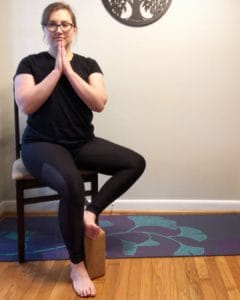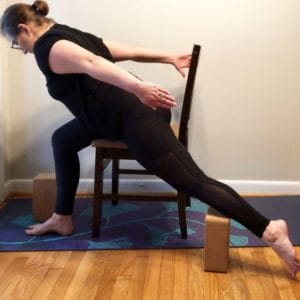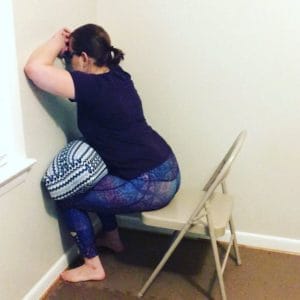So, what is adaptive yoga anyway? How can we incorporate it into our practice? Is it important to learn about trauma informed yoga? As we move into this New Year, many of us aspire to create a space where yoga really is for EVERY BODY. We interviewed My Vinyasa Practice’s Rachel Malpasso to learn how we can do just that. First, let’s find out more about Rachel.
 Hello, I’m Rachel Malpasso and my pronouns are she/her/hers. After a traumatic brain injury in 2016, I began chair yoga in a rehab hospital. Although I was really resistant thinking there was no way that yoga could help, clearly it did. I accredit all 8 limbs of yoga as the greatest healing tool in my healing journey. It helped so much that I did yoga teacher training, and well now, I’m working within yoga full-time! I’m an E-RYT 200, RYT 500, and YACEP. Plus, I have additional training in trauma-informed yoga, adaptive yoga, special populations, somatic yoga, and chair yoga. I’m a Certified Accessible Yoga Teacher and my dream is to make yoga accessible to all while linking physical and mental health.
Hello, I’m Rachel Malpasso and my pronouns are she/her/hers. After a traumatic brain injury in 2016, I began chair yoga in a rehab hospital. Although I was really resistant thinking there was no way that yoga could help, clearly it did. I accredit all 8 limbs of yoga as the greatest healing tool in my healing journey. It helped so much that I did yoga teacher training, and well now, I’m working within yoga full-time! I’m an E-RYT 200, RYT 500, and YACEP. Plus, I have additional training in trauma-informed yoga, adaptive yoga, special populations, somatic yoga, and chair yoga. I’m a Certified Accessible Yoga Teacher and my dream is to make yoga accessible to all while linking physical and mental health.
MVP: What is adaptive yoga and why is it important?
RM: Adaptive yoga means adapting yoga so that it is accessible to everybody regardless of gender, age, race, socioeconomic status, disability, geographic location, religion, sexual orientation, and any/everything else! It is adapting yoga to fit the person regardless of their level of flexibility, body size, or knowledge in yoga. Adaptive yoga is inclusive yoga.
Adaptive yoga incorporates all 8 limbs of yoga and reminds the practitioner that there are 7 limbs that have nothing to do with moving the body. Real yoga is a lifestyle that shows how to respond and experience each moment, not just asana. As Jivana Heyman says, “if you have a mind and a body, you can do yoga.” There is not a right or wrong way to do a pose if the purpose is achieved. It’s less of a focus on alignment and more on empowerment and range of motion. It’s remembering that we’re all shaped differently so our poses may look different, too!
Personally, I like to show those like me with chronic/terminal illnesses and disability a new way of looking at yoga. For example, instead of a standing Tadasana (mountain pose) like it’s typically thought of, I like to encourage people to think outside the box. Maybe that Tadasana is in the bed, home, hospital, floor, couch, or chair. Perhaps it’s even visualizing it and not moving the physical body. Think about the purpose and what makes it a pose. Well, Tadasana teaches basic alignment, improves posture, stability, strength and muscle tone, it’s focus is on the root chakra and element of earth, and so on. Now, picture the pose in your mind. Then change its orientation, consider gravity to achieve the purpose, the students’ abilities, and what props you can use. The world is your oyster!
Adaptive yoga is important because in a world where everyone wants to fit in, yoga can feel quite exclusive if the student does not realize they can absolutely look different than the teacher or others in the class. In the western world, people think yoga is a pretzel-shaped skinny White person wearing expensive clothes, but it’s my mission to show people that isn’t necessarily true. Yoga is so much more than flexibility or practicing the traditional variation of a physical posture. One must use their mind, body, and spirit to reach one’s highest potential.
MVP: What types of conditions could benefit from adaptative yoga?
RM: Book 2 Sutra 31 says, “these great vows are universal, not limited by class, place, time, or circumstance.”
 I think that this means literally anything and everything, anyone and everyone, can benefit from adapting yoga. Everyone like those with injuries, illnesses, and disabilities. But also those who are recovering from surgery, those with mobility differences, or those with chronic conditions such as high blood pressure, glaucoma, arthritis, Multiple Sclerosis, Parkinson’s, stroke, brain injury, spinal cord injury, osteoporosis, pain, intellectual and cognitive differences. Everyone like marginalized groups such as those who are LGBTQIA+, seniors, pregnant, Deaf, Blind, racial/cultural/religious minorities, homeless, felons, refugees, immigrants, those in larger bodies, or even a lower socioeconomic status. Again, everyone, even for those who take medication and have potential side effects or those who are simply having a bad day. Everyone can benefit from adapting yoga to fit their unique needs.
I think that this means literally anything and everything, anyone and everyone, can benefit from adapting yoga. Everyone like those with injuries, illnesses, and disabilities. But also those who are recovering from surgery, those with mobility differences, or those with chronic conditions such as high blood pressure, glaucoma, arthritis, Multiple Sclerosis, Parkinson’s, stroke, brain injury, spinal cord injury, osteoporosis, pain, intellectual and cognitive differences. Everyone like marginalized groups such as those who are LGBTQIA+, seniors, pregnant, Deaf, Blind, racial/cultural/religious minorities, homeless, felons, refugees, immigrants, those in larger bodies, or even a lower socioeconomic status. Again, everyone, even for those who take medication and have potential side effects or those who are simply having a bad day. Everyone can benefit from adapting yoga to fit their unique needs.
MVP: What resources do you recommend for making yoga more adaptable?
RM: I have so much to share! My best resource is getting involved with Jivana Heyman and Accessible Yoga (where I’m an ambassador). Susanna Barkataki is also a fabulous resource for cultural appropriation and Michelle Cassandra Johnson for anti-racism work in yoga spaces. Check out Octavia Raheem, Amber Karnes, Dianne Bondy, Hala Khouri, Nityda Gessel, Donna Noble, Carey Sims, Melanie Waldmen, Jessica Parsons, Sarit Z Rogers, Tristan Katz, Maris Degener, Tiffany Roe, Ashley Turner, Tracee Stanley, Brene Brown, Sarah Matchen, and oh so many more.
On Instagram, follow #accessibleyoga and you’ll find others that way like @johnny_eh, @sunnybeeyoga, @lvcyau, @annswansonwellness, @whereswaldman, @deafhoodyoga, @accessibleyogatraining, @accessibleyoga, @donnanobleyoga, @finding_torikins, @setucommunity, @sheelacheongyoga, @amberkarnesofficial, @tmkatzcreative, @iam_phoenix_rising, @heytiffanyroe, @abbywiththerods, @susannabarkataki, @irenelyon, @tracee_stanley, @fierce_calm, @sonyareneetaylor, @carson_tueller…. And so many more but this will turn into 50 pages.
MVP: What advice do you have for yoga teachers looking to lead adaptive classes?
RM: My best advice is to remember that you cannot see the vast majority of what your students are experiencing, so don’t assume anything. Yes, you can look for grimaces or someone making a grossly anatomical error, but you cannot see what they’ve experienced in life. We’re all different and we each bring our own perception into the room. You can’t see trauma, anxiety, depression, losing a loved one, an invisible disability, gender, or headache. You can’t see where someone grew up or what their finances look like.
For example, on the outside, I look like a pretty normal, able-bodied individual so teachers don’t usually think that a pose may be hard or impossible for me. Before I became a yoga teacher, I was literally told to “rest” in child’s pose for most of the class because teachers didn’t know what to do with me. After becoming a teacher myself, I learned how to create variations for what felt good in my body at that moment. This inspired me to share this idea with others. Another example is when a teacher used gendered language in a traditional vinyasa class and said “ladies, feel your womb”. What that teacher couldn’t see is that I had a hysterectomy and do not have a womb, and that was quite activating. Also, what if someone else did not identify as female or a lady?
My goal as a yoga teacher is to empower my students to find what works best for them. My goal for teachers in training is to embody this mindset and drop the “yoga must look like this” attitude. PS, what is this anyway?! There is no right or wrong way to a pose if the purpose is achieved. Plus, we have 7 other limbs!
MVP: What is your favorite adaptive pose? What props do you use?
RM: First, literally any pose can be adapted in any sort of way. Maybe it’s helpful to think of “adapting” as just another way of doing something. Take coffee for example: some people like it black, others like it with sugar, soy milk, or cow’s milk. Whatever someone puts into it, it’s still coffee.
So, you don’t even have to say adaptive or modifying. You can say find your flavor, variation, style, option… choose what works for you! So really, I guess you’re asking me more of what is my favorite pose and how do I do it? Because adaptive yoga is still just regular ole yoga 🙂
To answer your question, I was trying to think of the most creative thing I’ve done, but I have settled on my favorite pose being my personal variation of downward facing dog. I like to do this pose throughout the day over my kitchen counter, using a chair, my desk, the wall, bed, basically anything. When I feel like I need a good full body stretch, I firmly plant my hands on a surface in front of me, making sure to activate all the finger pads and squeeze my elbows towards my sides. Then, as I start to straighten my arms, I step back with one foot, then the other. I inhale deeply and go up on my toes for a moment. Then, an audible exhale as I draw the heels towards the ground, hips towards the sky, and belly towards my thighs. It feels really good and energizing to me when I stretch out the whole body like this.
If standing is not accessible, this same type of downward facing dog motion can be performed seated in a chair positioned near a surface to put weight into. Put on your thinking cap and try it out! Maybe even try on the back — the arms and legs can make a V shape. It does not have to look a certain way!

MVP: What do you see for the future of adaptive yoga?
RM: One of the main things I envision changing is this new online world that covid-19 has brought us. Think about all the people who had trouble leaving their home, getting to a studio class, feeling welcomed in a studio class, paying for the studio class, finding childcare, etc. Now the biggest struggle, I think, is how do we reach people who do not have internet access.
Plus, I truly hope that more and more people start learning about what adapting means. I hope that more teacher trainings begin to incorporate this, and that as we all learn, we all share. I hope that everyone reading this will make it their mission to incorporate more inclusion into their classes and it just goes further and further. One of the reasons I chose to work at My Vinyasa Practice is the values of authenticity, accessibility, and affordability. I hope that all of our students embody these through their teaching as well.
MVP: What is trauma informed yoga?
RM: According to the Department of Veteran Affairs, experiencing trauma is not rare. 90% of clients in behavioral health settings have experienced trauma, plus 61% of men and 51% of women have experienced at least one traumatic event in their lives. Examples of trauma can include physical, mental, verbal, or sexual abuse; bullying, medical trauma, early childhood abuse, disasters, violence, terrorism, traumatic grief, refugee trauma, and so much more.
Trauma often affects people by feeling a loss of control and a loss of choice. As I said earlier, you can’t see whether someone has experienced trauma, so my thought is to just assume someone in your class has, unfortunately. Simply put, trauma-informed yoga allows for students to recognize and accept the physical sensations in their bodies, which over time, helps them to feel safe in their bodies. Yolanda Hadid says, “healing does not happen on our schedule. It doesn’t have a clock or a calendar” so remember that you cannot force anything to happen. You just empower your students to find this healing journey in their own time.
MVP: What are important considerations when teaching trauma informed yoga?
RM: Think about ahimsa (non-harm), read about trauma, be mindful of your words and the environment you are creating, know your limits, and be prepared to refer to professionals trained in trauma like counselors and psychiatrists if needed.
For someone who dissociates from their body as a defense mechanism, using imaginative language or guided imagery may  not always be helpful or harmless. Avoid telling the class how the pose “should” feel or its intended effects because the way you feel in your body does not mean anyone else does. You don’t want to come up from behind, stand too close, invade someone’s space, or surprise them in any way. Instead, be in their vision and softly speak to let them know you’re coming closer.
not always be helpful or harmless. Avoid telling the class how the pose “should” feel or its intended effects because the way you feel in your body does not mean anyone else does. You don’t want to come up from behind, stand too close, invade someone’s space, or surprise them in any way. Instead, be in their vision and softly speak to let them know you’re coming closer.
Remember that some students want to use props like straps and blankets, which adds to their feelings of safety and comfort, but others may feel restricted and trapped. Instead of telling people to close their eyes, make sure you offer an option to keep the eyes open, perhaps softening the gaze, which helps with feelings of safety and learning how to soften and relax. Consider how vulnerable some poses might make people feel. Emotionally vulnerable people may feel they must say “yes” — watch their body language. Remember that some groups are unable to “leave things outside the room” because the world isn’t always safe and doesn’t stop or change just because of your yoga class. Remember your privilege, whether that is race, gender, ableism, age, etc. Use gender neutral verbiage. Some people come to yoga for healing and need to talk about their trauma, while others do not want to talk about it — hold space for both. Since we are striving to create a safe atmosphere, never assume someone wants to be touched. It is imperative that we only offer hands-on adjustments AFTER receiving permission to touch EACH time. Don’t single anyone out and give everyone equal attention, remember your class isn’t a social hour, and consider the hierarchy of the class.
It’s a lot, I know. Most importantly, remember your language is extremely important, and that it’s not our job as teachers to tell a student what they need. We as teachers are empowering and providing ways for students to determine what is best for themselves.
*Note, 8 limbs refers to the yamas (self-restraint), niyamas (observances), asana (physical postures), pranayama (breath), pratyahara (withdrawal of the senses), dharana (concentration), dhyana (meditation), and 8 samadhi (pure bliss).
Rachel L. Malpasso (she/her/hers)
M.S.; E-RYT 200; RYT 500; YACEP; Certified Accessible Yoga Teacher
